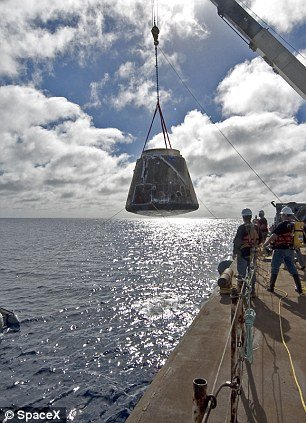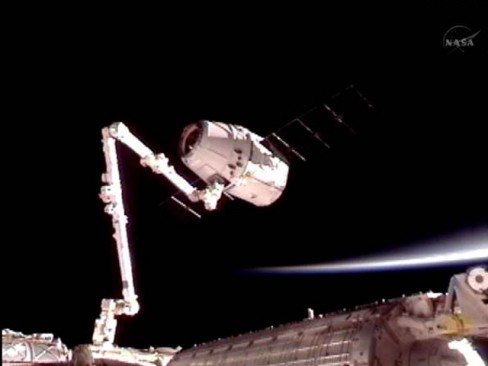Home Tags Posts tagged with "cargo capsule"
cargo capsule
The first commercially contracted re-supply mission to the International Space Station (ISS) has begun.
A Falcon rocket carrying a Dragon cargo capsule lifted clear of Cape Canaveral in Florida at 20:35 (00:35 GMT).
The robotic Dragon ship will deliver 400 kg of food, clothing, experiments and spares to the orbiting platform’s six astronauts.
It is the maiden flight in a sequence of 12 missions that California’s SpaceX company is performing for NASA.
NASA is looking to the private sector to assume routine transport duties to and from low-Earth orbit.
It has given SpaceX a $1.6 billion contract to keep the ISS stocked up with essentials, restoring a re-supply capability that the US lost when it retired the shuttles last year.
The terms of the contract kicked in following a successful test of Dragon’s systems in May.
That demonstration saw the capsule berth with the ISS – the first commercially designed and built vehicle to do so – and then return safely to Earth.
NASA has a second company it hopes also can soon begin operational cargo deliveries to the station.
The Orbital Sciences Corporation (OSC) will shortly test its new Antares rocket before undertaking its own ISS demonstration with a robotic vessel called Cygnus.
If that mission – tipped to take place next year – goes well then it will trigger a $1.9 billion contract for Orbital.
NASA wants eventually to put astronaut transport in the hands of the private sector, too.
SpaceX is eyeing this business as well, and is developing the critical life-support and safety systems that would turn Dragon into a human-rated vehicle. The company says it is just a few years away from being able to provide an astronaut “taxi” service.
NASA’s policy of outsourcing its cargo and crew transport needs is intended to find savings that can be ploughed back into building a rocket and capsule system capable of taking humans beyond low-Earth to more challenging destinations.
“We’re handing off to the private sector our transportation to the International Space Station so that NASA can focus on what we do best – exploring even deeper into our Solar System, with missions to an asteroid and Mars on the horizon,” explained agency administrator Charles Bolden.
Sunday’s nine-minute, 14-second ascent to orbit appeared flawless.
The Falcon dropped the Dragon off in an elliptical path running from 197 km above the Earth out to 328 km.
“Dragon was inserted into a picture-perfect orbit,” said SpaceX president Gwynne Shotwell.
“Its solar arrays deployed and it’s driving its way to station. So, that’s just awesome.”
Dragon must raise itself to the ISS’s altitude, which is presently at more than 400 km.
It is scheduled to arrive at the station on Wednesday. It will follow the routine established in May of parking itself just below the platform so that it can be grabbed by a robotic arm and pulled into a berthing port.
The attachment should take place at about 05:40 GMT.
Dragon is expected to return to Earth at the end of the month.
Its cargo then will include broken machinery and science materials that need to be handed back to researchers.
SpaceX Dragon cargo capsule has splashed down in the ocean off the California coast.
The return to Earth completes a historic first mission to the International Space Station (ISS) by a privately operated vehicle.
Impact with the water was confirmed at 08:42 Pacific Daylight Time.
Fast boats positioned in the splashdown zone were despatched to recover the unmanned capsule.
Early data suggested Dragon came down very close to its targeted location about 900 km (560 miles) from the Baja Peninsula.
The mission was intended as a demonstration of the freight service SpaceX plans to run to the platform.

SpaceX Dragon cargo capsule has splashed down in the ocean off the California coast
It took half a ton of food and supplies up to the ISS astronauts, and brought down about two-thirds of a ton of completed experiments and redundant equipment.
A successful recovery of the capsule and its contents will trigger a $1.6bn (£1bn; 1.3bn-euro) contract with the US space agency (NASA) for 12 further re-supply trips.
Dragon’s fall to Earth was overseen by controllers at SpaceX’s headquarters in Hawthorne, California, and at NASA’s Johnson Space Center in Houston, Texas.
The journey home began early on Thursday when the vessel was unberthed from the ISS by the station’s 17.5 m (58 ft) robotic arm.
Astronaut Don Pettit, at the controls of the Canadarm2, then released the cargo ship to fly free at 09:49 GMT, just as the station was moving over the Southern Ocean.
Dragon fired its thrusters three times to take itself down and away from the platform. A final 10-minute burn some five hours later committed the capsule to a plunge into the atmosphere.
A range of ships and planes had been organized to track the return, which was slowed in the final minutes by three parachutes.
Once recovered, Dragon will be returned to port, and then transferred to Texas for inspection and for its cargo to be unloaded.
NASA has engaged SpaceX (Space Exploration Technologies Corporation) and another company, Orbital Sciences Corporation of Virginia, to fulfill logistics roles at the ISS.
The agency hopes the contracting out of freight duties will save it money that can then be re-invested in more daring activities beyond the station, at destinations such as asteroids and Mars.
The commercial cargo approach will be followed later this decade by crew transport services.
SpaceX wants this business as well, and is developing the safety and life-support equipment that would allow Dragon to double up as an astronaut taxi.
SpaceX cargo capsule Dragon returns to Earth on Thursday having spent a week attached to the International Space Station.
The unmanned vehicle will fall through the atmosphere to make a splashdown in the Pacific off the California coast.
Dragon mission made history last Friday by becoming the first privately produced craft to visit the orbiting platform.
The mission has been a demonstration of the freight service SpaceX intends to run to the station.
It has a $1.6 billion contract with the US space agency (NASA) waiting to be triggered on the successful recovery of Dragon from the ocean.
“It’s a very challenging phase of flight. Only a few countries have done this before so we’re not taking this lightly,” said SpaceX mission director John Coulurlis ahead of the re-entry.
Astronauts on the International Space Station (ISS) closed the hatch on Dragon on Wednesday after filling it with 660 kg (1,450 lbs) of experiments and failed equipment that need to come back to Earth.

SpaceX cargo capsule Dragon returns to Earth on Thursday having spent a week attached to the International Space Station
The crew has to unberth the cargo ship from the platform using its big robotic arm before releasing it to fly free.
Dragon must then fire its thrusters several times to take itself down and away from the station. A final burn will put it on a course for re-entry into the atmosphere.
SpaceX has organized a range of ships, planes and ground stations to track the descent of the capsule, which will be slowed in the final minutes by three big parachutes.
Dragon is projected to hit the water at 15:44 GMT (11:44 EDT).
“Our splashdown zone is about 490 nautical miles south-west of Los Angeles,” explained John Coulurlis.
“The recovery boats – it’s a fleet of three vessels with supporting fast boats that go out to safe the spacecraft.
“It will take about two to three days to return to port. We’ll then go direct to our facility in Texas for cargo unloading and further spacecraft inspection.”
SpaceX – Space Exploration Technologies Corporation – has been engaged by NASA to fulfill a logistics role at the station just as soon as it has proved its systems. The current mission was designed to see it complete a final set of performance milestones.
NASA has another such arrangement with Orbital Sciences Corporation of Virginia, although its freighter, known as Cygnus, is still several months from making its maiden flight.
The agency hopes that by contracting out the carriage of freight it will save money which can then be re-invested in more daring activities beyond the station, at destinations such as asteroids and Mars.
The commercial cargo approach will be followed later this decade by crew transport services.
SpaceX wants this business as well, and is developing the safety and life-support equipment that would allow Dragon to double up as an astronaut taxi.
[youtube bHKy__ZP3bo]


